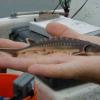Auban wrote: "The thing I find interesting to think about is that drainage ditches are entirely man made structures. They are providing environments for all kinds of little critters to live in that may otherwise have no other suitable habitat later on down the road."
In most cases, a drainage ditch is a man-made replacement for a natural drainageway (stream or wetland). These sites presumably had all sorts of native critters for millenia before they were converted into ditches. Relatively few ditches are "entirely man made" (in places that were not waters or wetlands prior to ditching). This is a hot button in the arguments for and against regulating construction impacts to "ditches" to protect water quality.










